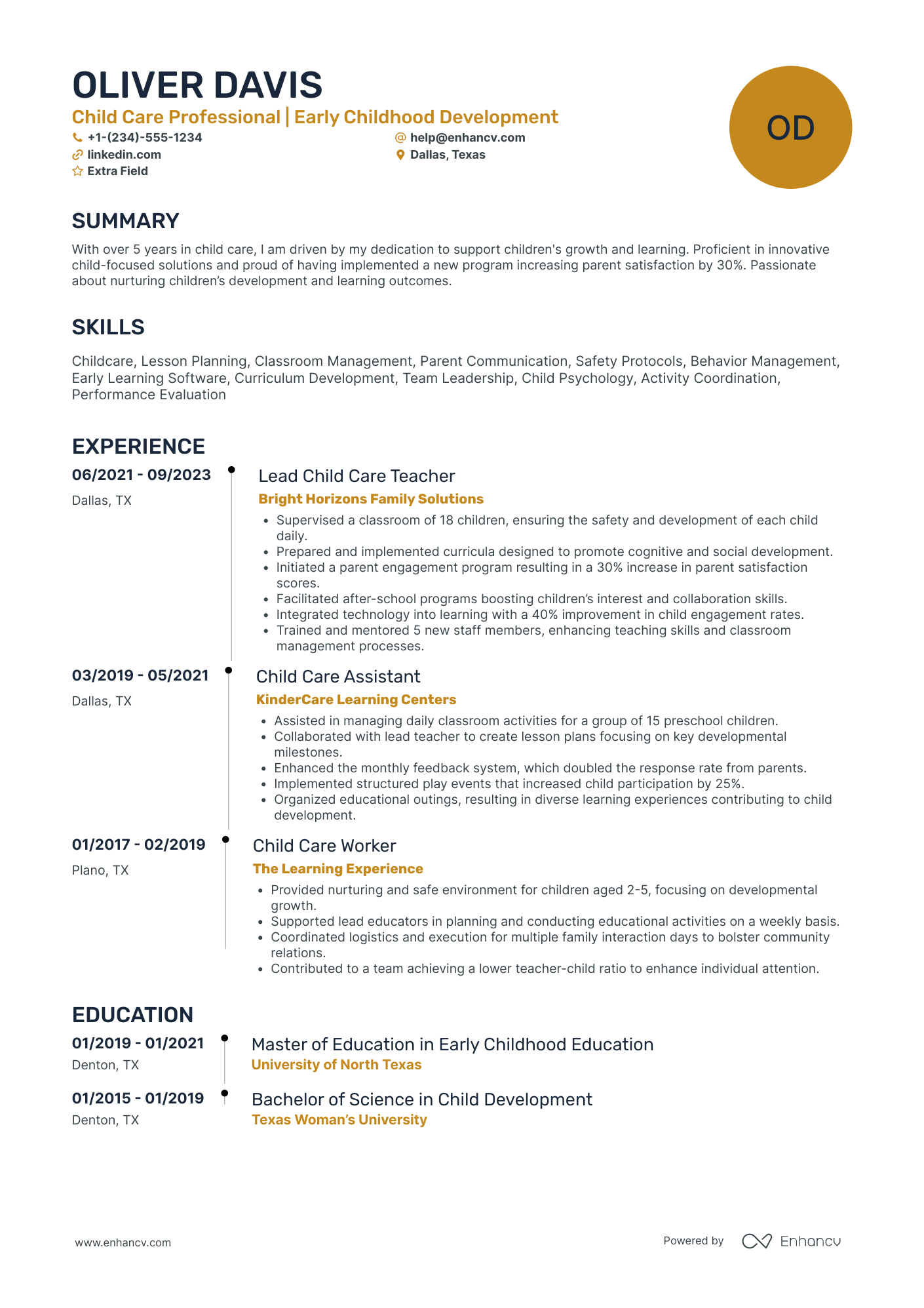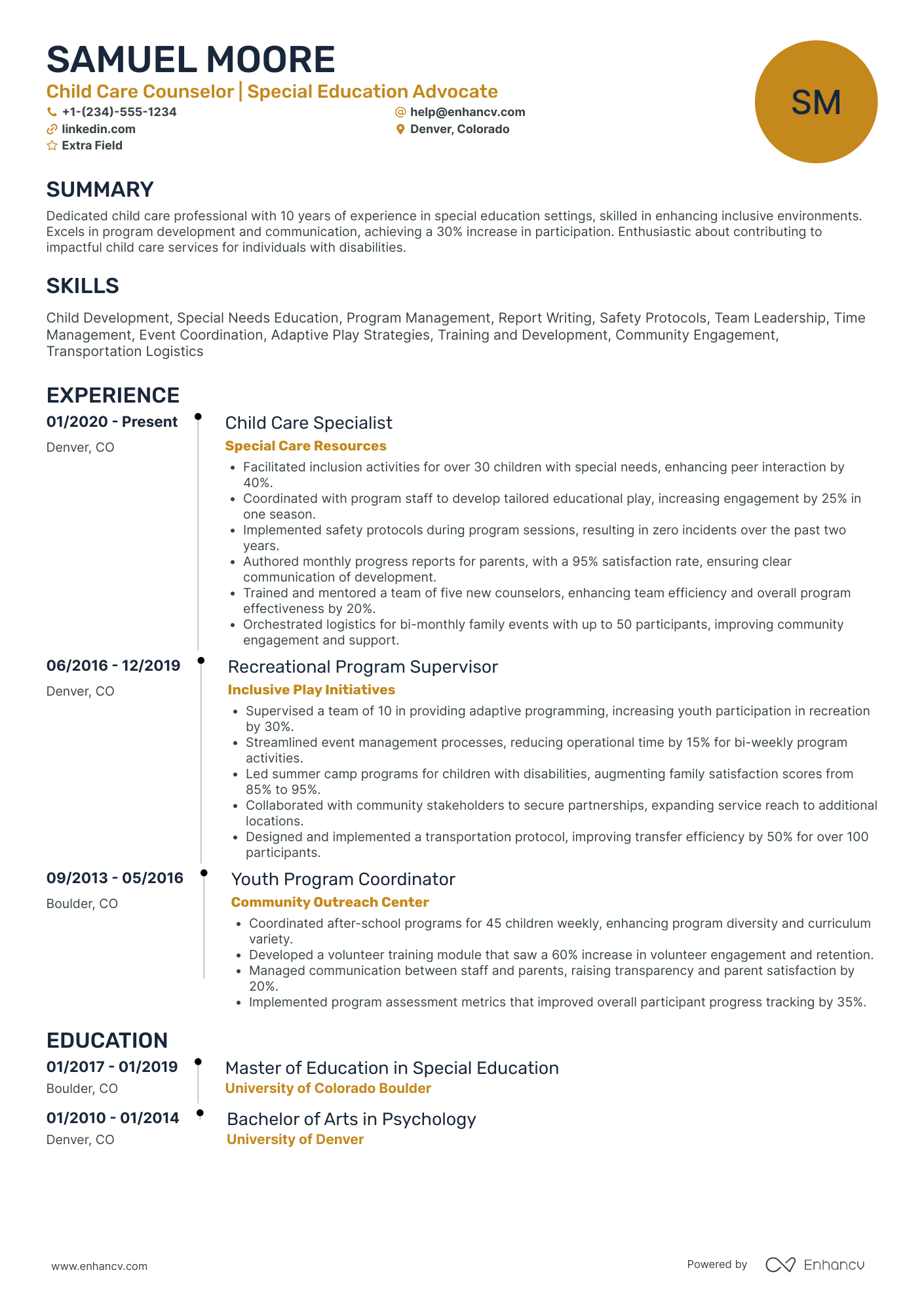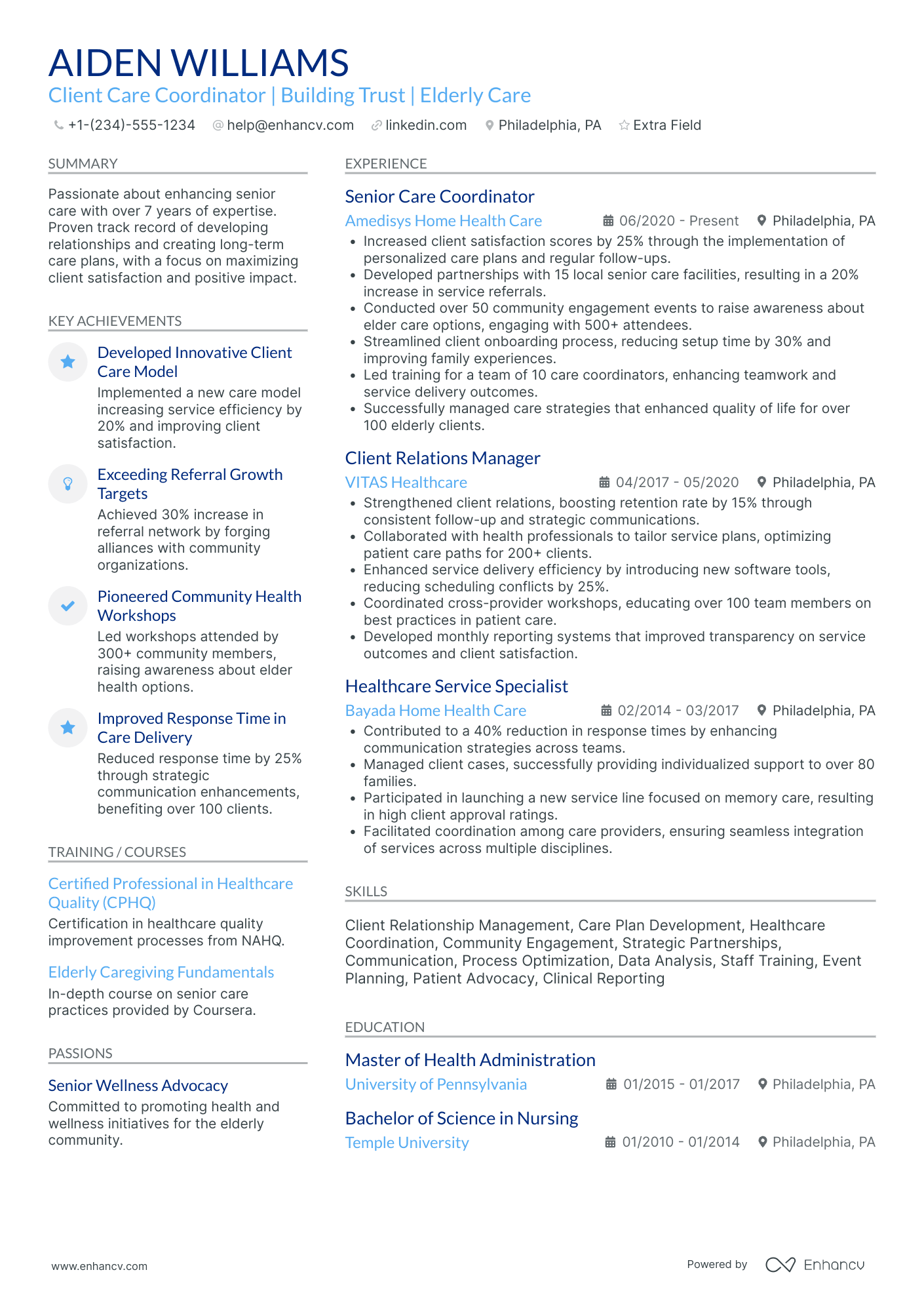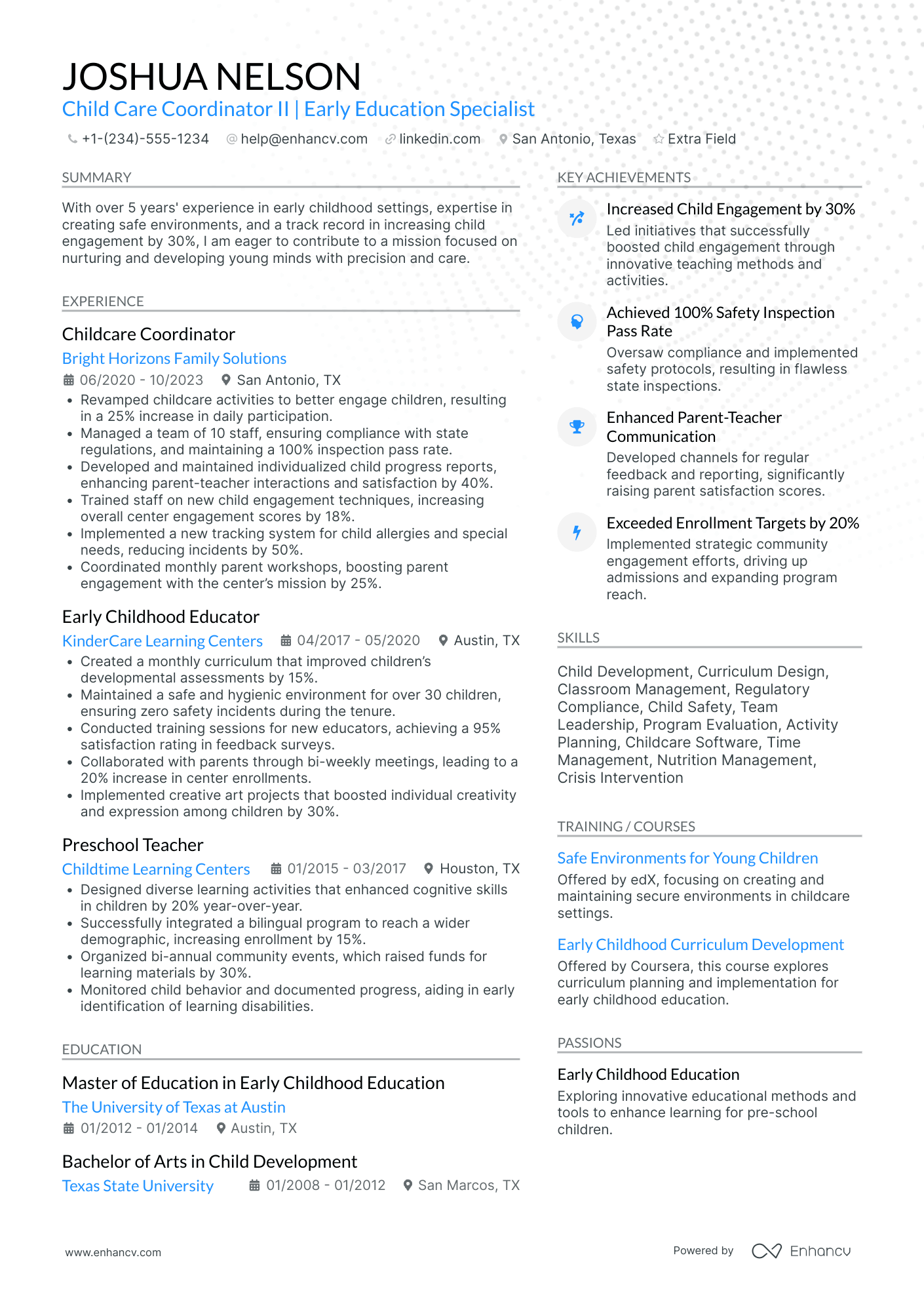Creating a child care resume comes with some unique challenges that can make creating an attention-getting resume as difficult as trying to calm down a rambunctious child on a sugar high.
Many child care workers need to decide whether to focus more on technical skills and education over demonstrating practical experience through personal child care responsibilities and volunteer work. The trick is to highlight both technical and personal skills in a way that recruiters and families can understand.
In this guide, we will help you create a professional child care resume using real-world examples to show you which skills and experience you need to highlight. We will cover each section and show you how to:
- Demonstrate high-level skills in child care by listing certifications in First Aid/CPR, early childhood education, and child development.
- List volunteer work, internships, and part and full-time jobs that highlight practical experience in caring for children in specific age groups.
- Include professional social media links and websites to show your connection to the child care community and your commitment to providing top-notch care.
- Create a tailored child care resume to help you stand out in a crowded field.
If you need a different type of child care resume, check out these resume examples for similar caregiver roles.
Child Care resume examples
By Experience
Senior Child Care Coordinator
Entry-Level Child Care Worker
By Role
Child Care Coordinator
Child Care Consultant
Child Care Advocate
Child Care Administrator
Child Care Assistant
Child Care Supervisor
Child Care Case Manager
Child Care Counselor
Child Care Specialist
Child Care Program Manager
Child Care Center Director
Child Care Aide
Child Care Services Manager
Child Care Development Specialist
The first step in crafting your resume is knowing the proper format. No matter what type of job you are applying for, you need to stick with a standardresume format.
Play is often talked about as if it were a relief from serious learning. But for children, play is serious learning. Play is really the work of childhood.
Fred Rogers
How to format a child care resume
A resume is a collection of skills, experience, and education presented in an easy-to-read format. While you can find resume templates that already have the correct elements and neatly divided resume sections, you should still be familiar with the basics.
The standard resume format includes one-inch margins on all sides, single-line spacing, and a font size between 10-12. These are the standard settings for most documents, so if you are building a resume from scratch, you don’t need to worry about them.
Here are a couple of other things you should know about resume formats before we move on:
- Make sure the resume header has the correct contact information and a link to a professional LinkedIn page.
- List all work and education entries in reverse chronological order.
- The maximum page length is two pages.
- Only use a serif or sans-serif font.
Let’s talk a little about font choices on your resume. When you look at the number of fonts available, it can be a little overwhelming. There are tens of thousands of unique fonts available to choose from. While you may be tempted to use a more creative font, it can be harder to read and may result in your resume being ignored.
Enhancv resume templates come preset with all of the top resume sections and a list of modern fonts, like Exo 2, Lato, Rubik, Montserrat, Volkhov, and others.
One last word about formatting before we continue. Save your resume as a PDF document (.pdf). This will preserve the format of your resume, no matter what operating system or screen size they read it on.
Each market has its own resume standards – a Canadian resume layout may differ, for example.
Is your resume good enough?
Drop your resume here or choose a file. PDF & DOCX only. Max 2MB file size.
If you want to see how your current child care resume compares with other professional resumes, run it through our resume checker for an in-depth analysis.
To get you thinking about what to include on your resume, here are the things that recruiters and families want to see on a resume:
The top sections on a child care resume
- Personal profile: A personal statement about your passion for caring for children and a brief description of your child care accomplishments.
- Child care experience: Families want to know the person they hire has practical, hands-on experience caring for children within a specified age range.
- Certification and advanced child care training:In this industry, specific child care training and health certification are prioritized over post-secondary education.
- A wide range of skills: In addition to personal skills, you want to demonstrate experience in child care software and materials like Montessori materials, ClassDojo, and ABCmouse.
- References: Direct contact with past employers is an excellent way for your new employer to get a sense of your abilities and accomplishments.
Here are the areas you should focus on the most when adding your child care resume experience and skills:
What recruiters want to see on your resume
- Past work experience: Include any relevant part and full-time jobs, volunteer work, internships, and personal child care experience that demonstrates child care abilities.
- Certifications: In addition to first aid and CPR certifications, there are advanced certifications available that showcase your ability to care for special needs children and those with learning disabilities.
- Patience and compassion: These qualities are especially important for child care workers to show how resilient they are and that they can handle children who are being temperamental.
- Reliability: It is equally important that you demonstrate your ability to be on time and have excellent time management skills.
- Communication skills: Showing your ability to communicate with children, parents, and educators on your child care resume is essential as this job requires interaction with children, parents, and professionals.
Before we get into adding your work experience, let’s talk about choosing between a single and two-column layout. Both options are acceptable, and despite any fear-mongering from social influencers, applicant tracking systems (ATS) can easily read single and two-column layouts.
If you search online for other child care resumes, you will see a mix of single and two-column layouts. A two-column layout allows you to add more details to a single-page resume, which cuts down on the amount of scrolling and is best for those with 5-10+ years of experience.
Play around with each layout to see which one works best with the amount of education, work experience, and skill sets that you need to include.
Now, it’s time to work on adding your relevant work experience to your resume. This will include any professional or personal work experience where you helped care for children.
How to write your child care resume experience
The resume experience section will take up the most space on your resume and is where you’ll demonstrate all of your child care history and accomplishments.
In this section, you’ll include any professional and personal child care experience, including raising your own children, babysitting the neighbor's kids, or volunteering at any child care facilities.
Each job entry will need to include the following information:
- Job title
- Name of family or care organization
- Location
- Dates of employment
- A bullet list of job details and accomplishments
Each job entry should include 4-8 bullet points that detail the work you did and how your work benefited the child’s development. When adding your past jobs, be sure to tailor your resume to the specific job post. Focus on the relevant keywords that they list, such as first aid and CPR training, early childhood development, conflict resolution, and nutrition and meal planning.
They should be on your resume if they are in the job post.
Let’s take a look at an example of a real-world child care resume experience listing to give you a visual of how this section should look:
- •Cared for multiple children ranging in age from toddler to preteen.
- •Performed all care duties as assigned as well as any special requests from the parents.
- •Ensured school-aged children made it to school on time and that they do all of their homework.
- •Talked with parents about any problems behaviors and advised on how to take care of the issues.
- •Worked to foster a warm and caring environment centered around trust and compassion.
With this example, you have to ask yourself: does this person give you a sense of being a well-organized and thorough child care provider?
Not really. The vagueness about their job responsibilities and the duties they performed leaves you with more questions than answers and doesn’t back up their last statement.
As a child care provider, you want your resume to show your effectiveness as a caregiver and how you use your skills to better the children under your care.
Let’s see if we can improve this example with some more specifics:
- •Provided optimal care to 4 children ranging in ages from 2, 5, 8, and 11.
- •Changed diapers, managed bath time, cooked meals, and performed light household cleaning.
- •Maintained school and extracurricular schedules and transported children to and from activities in a safe and timely manner.
- •Worked to foster a warm and caring environment centered around trust and compassion.
- •Communicated any significant events or concerns with the parents immediately and discussed options to work on any behavioral issues.
Now we have a better idea of this person’s ability and the type of environment they worked in. Notice how they were able to create a more concise list of job accomplishments that does a great job of:
- Using actionable verbs when describing past work experience.
- Indicating the exact number of children under their care, along with their specific ages.
- Listing specific keywords that detail child care duties.
- Demonstrating time management, organization skills, and lesson planning skills.
- Highlighting communication skills and their ability to communicate with children, parents, and professionals.
When listing your past work experience, only include up to 3 relatable jobs. Any more than that, and you run the risk of your resume becoming redundant because your work history took up too much space.
How to quantify impact on your resume
When detailing your work experience, you may have heard people say you have to quantify your actions with numbers and percentages. For child care jobs, this can be a bit more challenging, but not impossible.
To give you an idea of how this can look on a resume, check out these real-world examples of how you can quantify various child care metrics:
- Number of children under your care: “Utilized meal times as a fun learning opportunity, preparing healthy foods with 3 children and helping each child overcome food aversions.”
- Age range of children cared for: “Managed care for up to 15 children ranging in ages from 2-10 for 8+ hours per shift.”
- Hours of child development training: “Completed 20+ hours of health, safety, and nutrition training to achieve certifications in First Aid, CPR, and childhood nutrition.”
- Years of experience in specified child care field: “8+ years working with children aged 12-17 with behavioral and learning disabilities.”
- Child care settings: “Promoted safe behaviors and creativity while establishing basic peer and adult rules, reducing the instances of bullying by 62%.”
- Educational activities created/developed: “Developed and implemented 3 new learning activities that improved social interaction and behaviors in children living with autism by 23%.”
- Number of short-to-long-term contract conversions: “Developed and implemented new homework and play schedules that led to four short-term contracts becoming long-term contracts.”
- Percentage of childhood development improvements: “Coached children in school subjects and aided in homework, improving learning comprehension and test scores by 32%.”
While you don’t need to quantify every bullet point, you want to focus on quantifying the metrics that are listed in the job duties and responsibilities. For instance, if the job post reads:
The caregiver will be responsible for maintaining a high quality of care for children of all ages from infant to preschool. You will assist in feeding young babies, changing diapers, helping with potty training, and supervising children. The applicant will be required to follow a curriculum given and work with another teacher to create lessons that help children achieve age-appropriate behaviors and become kindergarten-ready.
If you are applying to this job, you want to tailor the details from your past job to quantify what they are looking for, like so:
- “Developed a new fun potty training activity that helped children learn potty skills that decreased daily accidents by 46%”
- “Worked with teachers and child care providers to develop 6 new lessons that focused on learning and early childhood development.”
How do I write a child care resume with no experience
If you are passionate about child care but don’t have any experience, there’s nothing to worry about. You can still create a resume experience section filled with jobs where you performed similar duties as a child care provider.
Recruiters aren’t concerned with job titles. What they want to see is relevant work experience that points to actual child care experience.
Focus on the jobs where you:
- Supervised children at a parent’s home or in a child care facility.
- Developed and implemented activities that promote physical, emotional, socil, and intellecual development.
- Performed basic care needs, such as changing diapers and toilet training.
- Created a daily routine for children to ensure they a healthy mix of play time, education, and rest.
- Participated in training and development of programs for special needs children.
The types of relatable jobs that you can add to your resume include:
- Camp counselors
- Preschool teachers
- Family babysitter
- Special needs assistant
- Daycare assistant
- Nanny
- Youth worker
When detailing relevant work experience, only focus on those duties that are specific to the job you are applying to. Like so:
- •Worked as a camp counselor for two summers, leading groups of 15+ children for a 6-hour camp day.
- •Worked closely with camp administrators and team members to ensure camp schedules ran smoothly.
- •Communicated with parents regarding needs and concerns and reported events to my direct supervisor.
- •Led arts and crafts projects and childhood-appropriate games, while ensuring the safety and well-being of each camper.
- •Followed all camp rules and protocols to maintain a safe and fun environment.
With this example, you can see how effective relatable jobs can be in showcasing your child care skills. From this example, we can see that this person is:
- Able to handle a large group of children throughout an entire 6-hour shift.
- A team player who is comfortable talking and working with parents, other counselors, and children.
- Experienced with leading various games and activities in a safe and fun manner.
- Capable of creating a safe environment based on camp rules and regulations.
Now that we have our resume experience section filled out, let’s talk about adding relevant technical and personal skills that all child care workers should have.
How to list your hard skills and soft skills on your resume
The next few sections of your resume are where you will list vital skills, such as knowledge of child management software, scheduling and planning tools, as well as interpersonal and empathy skills. These are the hard and soft skills that make for a well-rounded child care provider.
Hard skills define technical skills, like experience with Brightwheel, Montessori Crosswords, and development assessment tools. It also includes software like Microsoft Office for emailing and creating lesson plans, spreadsheets, and fun interactive presentations.
Soft skills are those skills that are more personal and aren’t necessarily taught. They include essential child care skills like active listening and communication skills, being able to think outside of the box, and emotional intelligence. We learn these through everyday experiences with our family, peers, and friends.
Listing hard and soft skills on your child care resume is essential as it demonstrates a person’s ability to handle any type of care situation that develops. Enhancv resume templates come with a variety of ways to display your hard and soft skills.
A technical skills section allows you to list relevant experience with educational and management software, development tools, and other necessary equipment and tools:
Our strengths section is where you will list your relevant soft skills:
Here is a list of the most sought-after hard and soft skills that child care facilities and families search for:
Best hard skills for your child care resume
- First Aid and CPR-certified
- Health and safety training
- Child nutrition knowledge
- Infant care expertise
- Early childhood education
- Multilingual
- Special needs care
- Child behavioral management techniques
- Knowledge of child psychology
- Learning strategies
- Developmental assessments
- Proficiency in child care management software
- Familiarity with child-friendly educational software
- Lesson planning
- Arts and crafts skills
- Music therapy
- Knowledge of outdoor games and activities
- Proficiency in educational technologies
- Driver's license
Best soft skills for your child care resume
- Patience
- Compassion
- Adaptability
- Creativity
- Problem-solving
- Communication
- Empathy
- Time management
- Active listening
- Observational skills
- Interpersonal skills
- Emotional intelligence
- Resilience
- High energy levels
- Sense of humor
- Positive attitude
- Stress management
- Dependability
- Leadership
- Decision making
- Creative storytelling
Adding skill keywords and applicant tracking systems
Applicant tracking systems (ATS) are gaining popularity in many recruiting offices and large companies. They help sift through all of the resumes they receive for a single position and identify the skills that the company or family is looking for.
They work by searching for specific keywords that are added to the system as a search parameter. It will search each resume for those keywords and phrases and score it on how many it finds.
You can improve your chances of scoring well with the system if you match the keywords word-for-word. If the post includes the name of specific software, make sure you include that in the work experience or skills section of your resume.
The next sections we will cover relate to your education and advanced training as a child care provider.
How to list your certifications and education on your resume
Unlike other careers, child care facilities and private residences place more emphasis on practical child care experience than any post-secondary education.
To make the most out of this section, you want to focus more on specific training in the area of child care you are specializing in, such as early childhood development or working with special needs children.
Your child care resume education section should include the following:
- High school diploma
- Associates degree
- Child care continuing education certificates
- Advanced child care certifications
For those who wish to pursue a bachelor’s or master’s degree in child care, there are degree programs available for early childhood education, child/human development, and family studies.
When listing your education on a resume, you want to include the degree name, school, and graduation date or dates of attendance, like so:
When listing your certifications on a child care resume, you only need to include the name of the certification and the institution that provided the training:
If you need to boost your training and income level, check out these top child care certifications.
Best certifications for your child care resume
Next, we will work on adding a personal statement to your resume. This is slightly different than the standard resume summary or objective.
How to write your child care resume summary or objective
The resume summary or objective statement is where you get to introduce yourself to a potential employer. It is the handshake before the handshake.
The way you format this section will depend on how much experience you have in child care. Those with 5+ years of experience will want to create a resume summary that includes one or two details of their accomplishments.
This section should have more of a personal feel to it and include the reasons why you are passionate about child care. Let’s take a look at a real-world child care resume summary so you can see what to do and what not to do.
Pretty impressive, wouldn’t you say? It includes specific details of their years of experience, the age of the children under their care, quantifies developmental metrics, and lists several certifications.
If you are applying to a large organization, this type of summary is fine, but it comes off as very cold and clinical. This is one area where child care workers struggle to balance their passion for raising children with their education and technical abilities.
Let’s see if we can give this summary a more personal feel:
Do you see how the use of “I am” gives this section a more personal feel? When applying for a job with a private family, you want to focus more on creating a personal connection than simply summarizing your career milestones.
In this situation, either example is fine to use, depending on the type of work environment. Families and small care facilities may feel a stronger connection with you if you use a more personal statement rather than the typical resume summary.
Optimize your resume summary and objective for ATS
Drop your resume here or choose a file.
PDF & DOCX only. Max 2MB file size.
Additional sections for a child care resume
So far, we’ve discussed the main sections of your resume: work experience, education, advanced training and skills, and the resume summary or personal statement.
There are additional resume sections that you can use to round out your resume, including other relevant skills, like nutrition education and your passion for child care. Have a look at these additional sections to consider adding to your resume:
- Awards: List any awards or recognitions in child care development or education.
- Networking: It is important to show your connection with others in the industry by including any memberships to national or local child care organizations and networking groups.
- Publications: Showcasing any published works, like blogs, articles, or books on child care development or education, is an easy way to impress future employers.
- Language skills: Use this section if the job calls for experience with a second language.
- Interests and hobbies: Including interests in arts & crafts, storytelling, or gardening points to your ability to teach children a wide range of topics.
Another section that you should consider adding to your child care resume is references. This section allows families or recruiters to call your past employers and ask for a personal opinion on your work ethic, reliability, passions, and achievements.
Make sure you ask your past employers if it is ok that you use them as a reference and how they prefer to be contacted.
There is one more section that child care workers can add to their resume that is often overlooked in this field—a portfolio
Including a portfolio on your child care resume
Having a portfolio is not just for artists anymore. A child care portfolio shows future employers that you have a positive web presence and gives them a chance to see all of your child care achievements in one place.
The types of information you can include in a portfolio are:
- Event planning and execution
- Curriculum development
- Community involvement
- Parental engagement
- Photos and videos of positive child interactions
Where can you place a portfolio link? The best place to include this is in the header section:
Notice how this example includes their CDA certification in the title. This is another section that you can tailor to the job post.
The best portfolio websites for child care workers are:
Key takeaways
Congratulations! You now have a professional resume that you can send out to recruiters and families and get the job you’ve always wanted. Throughout this guide, we show you the common mistakes that child care workers make when perfecting their resume and how to avoid them by:
- Combining a mix of professional and personal child care experience that demonstrates practical, hands-on child care experience.
- Listing education and advanced training in health and safety and child care specialties.
- Including professional and personal references.
- Demonstrating their connection to the child care community through professional associations, social media, and a website portfolio.
































